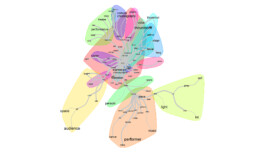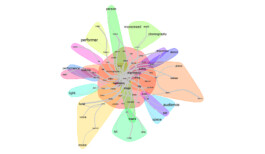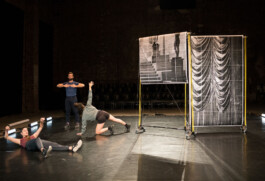
I KNOW IT WHEN I SEE IT
(2019)
Luísa Saraiva & Carlos Azeredo Mesquita
Between February and April 2019, Luísa Saraiva, Carlos Mesquita and Frances Chiaverini asked 45 dancers in several European cities to describe, in detail, real or fictional performances based on their experiences as dance professionals. Departing from these descriptions, they developed a performance that explores the collective memories generated by the interviewing process and the relation between movement and language as simultaneous meaning-making processes. The basis for the dialogue, movements, and attitudes of "I know it when I see it" comes from the imaginations of the 45 interviewed dancers. Their imaginary dances are reenacted, reinterpreted and bastardized.
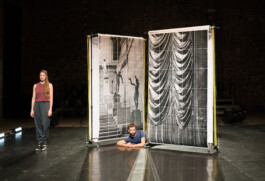

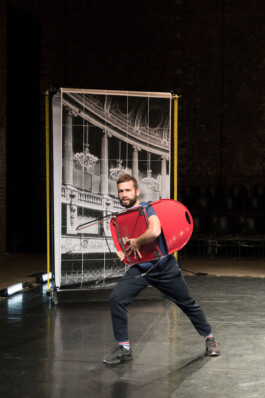
Concept, Artistic Direction Luísa Saraiva e Carlos Azeredo Mesquita
Artistic Collaboration Frances Chiaverini
Performance Frances Chiaverini, Carlos Mesquita, Luísa Saraiva
Text Analysis João Francisco Barreto
Music Julius Gabriel
Light Design Rui Barbosa
Sound Ricardo Cabral
Costumes João Rôla
Participants/Choreographic material gathered in collaboration with Aaron Davis, Alejandro Russo, Alexandre Archour, Ana Renata Polónia, Ana Rita Teodoro, Angela Diaz Quintela, Beniamin Boar, Blanca Noguerol Ramirez, Bryan Campbell, Catarina Miranda, Charlotte Virgile, Claire Vivienne Sobottke, Cristina Planas Leitão, Cyril Baldy, David Marques, Filipe Pereira, Francisco Pinho, Frank Willens, Ine Claes, Inês Campos, Jacob Storer, João dos Santos Martins, Johann Geidies, Jorge Puerta Armenta, Leyla Postalcioglu, Marco da Silva Ferreira, Marcus Baldemar, Margaux Marielle-Trehoüart, Maria Ferreira Silva, Meri Pajunpää, Michael Helland, Montserrat Gardó Castillo, Pedro Prazeres, Petr Hastik, Renan Martins de Oliveira, Rósa Ómarsdóttir, Sheena McGrandles, Simon Hartmann, Theo Livesey, Tiago Coelho, Tilman O’Donnell, Tyshea Suggs, Vincenzo Carta
A production from Luísa Saraiva & Carlos Azeredo Mesquita, coproduced by Circular Festival de Artes Performativas, with the support of Maschinenhaus Essen. Funded by Kunststiftung NRW, Fundação Gulbenkian, Stadt Essen, SHUTTLE (Câmara Municipal do Porto), Goethe Institut and with the support of Espaço do Tempo, Teatro Municipal do Porto, Circolando, Armazém 22 and Companhia Instável.
Premiere September 20th 2019, Circular Festival de Artes Performativas, Vila do Conde
Counseling for Future Dances
A
This is an exercise in guided imagination. You are to recall a vision of a performance you danced in last night. Take a moment to project yourself into the fictional past, noticing the details that compose the work you appeared in.
This vision for an imaginary dance should reflect your identity as a performer. It should include your desires, wishes and interests for a complete performance including details about the environment, sound, time, physicality and spectator perspective. Try to paint a picture in your head as clear as possible.
I will now ask you a series of questions designed to compose a vision of a dance that validates the artistic concerns that resonate with you. This is a dance that you identify with and artistically relate strongly to.
We’d like you to answer the questions fluidly and freely. Respond with the first images or ideas that come to your mind in a free associative manner. The description can be as detailed as you wish. This is a fictional memory. This is a dance that you identify with and artistically relate strongly to.
B
Now we’ll repeat the exercise. This time we’ll give you a slightly different prompt that is meant to conjure another imagined performance.
This is an exercise in guided imagination. Once again, you are to recall a vision of a performance you danced in last night. Take a moment to project yourself into the fictional past, noticing the details that compose the work you appeared in.
This vision should reflect a dance that, in general, does not validate or resonate with your artistic concerns and perhaps is not your preferred type of work.
This is a fictional memory. This vision should reflect a dance that, in general, does not resonate with your artistic concerns. It is a work in which you took part, but perhaps was not the ideal type of work you’d prefer to perform in.
1.
Thinking about the broad picture in your mind, notice the environment. Was the performance indoors or outdoors?
2.
Can you describe the space?
3.
How was the audience arranged?
4.
How many people attended?
5.
Thinking about your proximity to the audience, could you look into their eyes?
6.
How did you ‘enter’ the performance space?
7.
Can you describe the light? What tones/colors did it have?
8.
Was there a set?
9.
Were there any props?
10.
Was there sound or music?
11.
Were you performing alone?
12.
How many performers (men/women/others) took part in the piece? What gender(s) were you/they representing?
13.
What were you wearing?
14.
How was your hair?
15.
How would you describe the choreography?
16.
How was the movement?
17.
What was the movement about?
18.
Were there any choreographic tools used to generate the movement?
19.
Was there a theoretical/philosophical background?
20.
Would you associate the movement with a specific style or vocabulary or name it with specific terminology?
21.
Did you interact with the other dancers?
22.
Did you sweat?
23.
How long was the process to make the work?
24.
Did you interact with any of the spectators?
25.
How would you describe your gaze?
26.
How was your facial expression?
27.
Did you use your voice?
28.
Can you now show me an excerpt of this performance, including movement (and voice, if it’s the case), for as long as you wish?
29.
Who was the author of the performed work?
30.
What was the duration of the piece?
**** *s_019 *i_1 *sx_1 *a_02 *c_02 *n_05
The space is an inside space. The audience is sitting on 2 sides. I think it is immersive, so they are kind of part of the piece. The performance space… it is a miniature of a garden that is partly artificial and part natural, and that at all times could be deconstructed, it is maybe a bit of a brechtian space. The lights are working also with ideas of nature, so they are constantly moving. There is no use of strong colors. It is like an image of clouds passing, or winds through the grass. I could also imagine there was something like the movement of the sunset. The set is this garden, so it is maybe a big tree or a big rock. The props are instruments and costumes, a carcass, stones, baseball bats, a baseball costumes. There were also some animals. The performers were me, an older woman, a girl in her transition to becoming a woman and another performer that is hidden on an animal costume. Of course, there is also the person making the music who is also a performer, for sure. But on a different level. So we were 3 women, 1 person we do not know and 1 men that makes the music, probably 3 women and 2 men. There is a strong interest in femininity and sisterhood, but playing with masculinity. The costumes are nudity, a gym body with muscles and blond hair. And the animal costume. The choreography is intense, fragmented, partly very precisely set and partly open. Which means, that by performing it the choreography becomes clearer. The movement is intense, a lot emerging through the use of voice, it is expressive, it is moving in and out of narration and of creating temporary identities. The music and the sound are live, it is also intense. It can be sometimes like a field recording. (…) The voice is one of the motors of the work, it is used in different ways. It is used for speech, to sing, also a kind of raw voicing. Breath is for sure part of the work too. The facial expression is there and is also sometimes used as a material so it also controlled. The theoretical foundation is a lot of readings on the wilderness and the wild, the fascination for the texts of Jack Halberstamm. Lots of things that have been collected throughout the years and, in general, this idea of theory as a form of touching. I am the author, but I think the collaboration is really important, or the encounter with the elements or the people that are part of the work, is extremely important, especially with the person who works with the music, who is also an author for sure. The work is the product of a constellation.
**** *s_016 *i_3 *sx_1 *a_02 *c_04 *n_06
The venue is a closed space. The people sit around all around but they can change places. The performance takes place on a square space in the middle. The light is very scenic, with spotlights pointing to the floor, creating patterns and shapes. The props come and go, the performers bring them in and take them away. There are 9 performers, 5 girls and 4 boys. There is not a set choreography, but a set of actions. The movement is very personal and emotional and the performers are saying their innermost secrets and fears in a very heartfelt and deeply personal way. There are animals on stage that they kill with knives and with the blood they draw a pattern on the floor by dragging the dead animal around. Goats mostly. The music is very noisy and crazy and it mixes with the voices of the performers who talk directly into the eyes of the audience. The facial expressions are very lively and trying to connect with the audience. It is a performance related to political problems, address the issue of people not being able to cross borders or being allow in the land of others.
**** *s_001 *i_1 *sx_2 *a_02 *c_01 *n_01 *score_1
I have done it because I was so well supported by a particular institution. The venue, the space has a wooden floor, there are white walls and it is like a big theatre room. The audience is arranged on either side with a slight tip and they are a little bit like they are about to go over the rollercoaster. The tribune is a bit inclined, so it is like slightly strange to sit there, not uncomfortable. The performance space is in between where the two audiences are sitting. They are on each side of the performance space. The lights are a mix between natural light and cold theatrical light, not LED. Older stuff like 5K or even an HMI is nice, but that would be too big for the space. The set is me and the people, so there is no props or walls. (…) I did not want gender to be on the foreground of the performance. Of course it is always there hanging out, and for those who see it they see it and for those who are less concerned with it, they may not see it. The costumes are green Carhartt pants, light t_shirt or blue buttoned down shirt and barefoot. And the choreography is not set, but it is kind of scored, and that score is written and it changes, the writing of it changes each iteration of the performance. The movement is brilliant! Precise, soft, clear, gentle. I like gentle, that is good. There is no particular sound except the sound of birds. (…) The sound of birds becomes clearer when it becomes a way of knowing what is happening, what is the concentration in the room. So, when I hear the sound of birds more clearly than how I see, then I know something is happening, and the choreography of the performance is really taking off. And sometimes the bird sounds are annoying, because they are repetitive, even though birds have nice sounds, they are like, a little bit repetitive. I do not use my voice like explicitly, sometimes I hum and sometimes I make noises, a little bit by accident. My facial expression is varied, changing all the time. Some people do tell me that I look a little bit serious, so I am working on that. There is no explicit theoretical foundation, except the question of how non_separation or softer relationship to the separation of subjects or objects could be explored. (…) And I am the author, but it is very co_authored by the people who watch as well. The piece comes as a result of a one year process.(…) So every sunday I meet with audience members, it is like there is a performance every week. Yesterday was, I guess, the finishing point of this one year. I would not say it is the end of the piece, because I would like to do other things with it, but it is the end of this commitment, period of commitment, between myself and the audience.
**** *s_013 *i_2 *sx_1 *a_02 *c_04 *n_06 *score_2
You can identify the gender clearly and you see a woman wearing a dress, half dressed and half naked, but the dress behaves in a way that when she moves it reveals certain body parts, such as the breast or the ass. This dancer is falling on her knees a lot, and you can see she is sweating and while she moves her hair touches her body and she is throwing herself agains the ground and she is becoming very tired. There is very strong music, sacred music. Her facial expression is that of pain. The light is coming from the side, in a way that gives more volume to her movement. Behind her there is a set of other dancers that are only observing her falling. Those dancers are in a fixed posture and they cannot move and will not move. The piece takes place in a golden theatre, with a big chandelier hanging in the middle, a red curtain visible on the side of the stage. Finally, when she gets really tired and fall on the ground, you can see she almost stars crying. That is the moment when the other dancers come from the back and walk slowly towards her and lift her and make a dance with there above their heads. The author is a male choreographer. His theoretical foundation is based on invisible white male power. The piece was very long, with a break for wine between the two parts.
